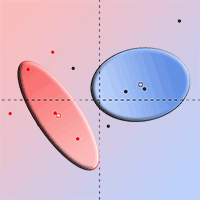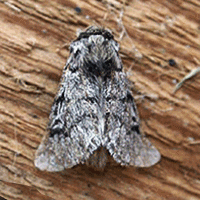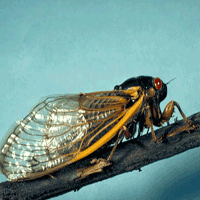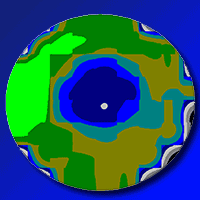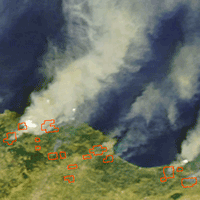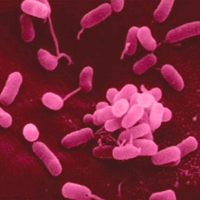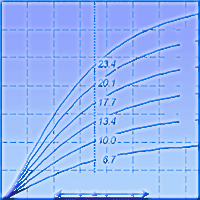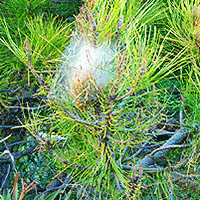
Plant phenotype affects oviposition behaviour of pine processionary moth and egg survival at the southern edge of its range
Sara Hezil (1) , Gahdab Chakali (1), Andrea Battisti (2)
iForest - Biogeosciences and Forestry, Volume 11, Issue 5, Pages 572-576 (2018)
doi: https://doi.org/10.3832/ifor2675-011
Published: Sep 01, 2018 - Copyright © 2018 SISEF
Research Articles
Abstract
Morphological traits of Aleppo pine (Pinus halepensis) needles in native and planted stands at the southern edge of its range influence oviposition behaviour of the pine processionary moth (Thaumetopoea pityocampa). Extreme environmental conditions result in a reduction in needle size of the host plant which corresponds to a lower rate of fecundity in the moth. Our results showed that egg batches were laid closer to the needle buds, especially on native trees with short needles, and this resulted in increased egg mortality. Number of eggs laid by the female moths did not vary between native and planted stands, nor did the number of parasitized eggs of the two common Hymenopteran parasitoids, Baryscapus servadeii and Ooencyrtus pityocampae. The observed differences in egg mortality are likely due to abiotic factors associated with the position of the egg batch on the needles. Thaumetopoea pityocampa eggs require a thermal niche for optimal development, and further measurements are required to determine the thermal threshold of these eggs. Understanding the role of climate in T. pityocampa populations will be an important factor for the survival of the Aleppo pine forests and protecting it from desertification.
Keywords
Algeria, Egg Parasitoid, Pinus halepensis, Plantation, Thaumetopoea pityocampa
Authors’ Info
Authors’ address
Department DAFNAE-Entomology, University of Padova, Agripolis, I-35020 Legnaro, PD (Italy)
Corresponding author
Paper Info
Citation
Hezil S, Chakali G, Battisti A (2018). Plant phenotype affects oviposition behaviour of pine processionary moth and egg survival at the southern edge of its range. iForest 11: 572-576. - doi: 10.3832/ifor2675-011
Academic Editor
Massimo Faccoli
Paper history
Received: Nov 03, 2017
Accepted: Jul 03, 2018
First online: Sep 01, 2018
Publication Date: Oct 31, 2018
Publication Time: 2.00 months
Copyright Information
© SISEF - The Italian Society of Silviculture and Forest Ecology 2018
Open Access
This article is distributed under the terms of the Creative Commons Attribution-Non Commercial 4.0 International (https://creativecommons.org/licenses/by-nc/4.0/), which permits unrestricted use, distribution, and reproduction in any medium, provided you give appropriate credit to the original author(s) and the source, provide a link to the Creative Commons license, and indicate if changes were made.
Web Metrics
Breakdown by View Type
Article Usage
Total Article Views: 44293
(from publication date up to now)
Breakdown by View Type
HTML Page Views: 37464
Abstract Page Views: 2899
PDF Downloads: 2957
Citation/Reference Downloads: 4
XML Downloads: 969
Web Metrics
Days since publication: 2683
Overall contacts: 44293
Avg. contacts per week: 115.56
Citation Metrics
Article Citations
Article citations are based on data periodically collected from the Clarivate Web of Science web site
(last update: Mar 2025)
Total number of cites (since 2018): 4
Average cites per year: 0.50
Publication Metrics
by Dimensions ©
Articles citing this article
List of the papers citing this article based on CrossRef Cited-by.
References
Natural history of the processionary moths (Thaumetopoea spp.): new insights in relation to climate change. in: “Processionary Moths and Climate Change. An Update” (Roques A ed). Springer, Dordrecht, Netherlands and Quae, Versailles, France, pp. 15-80.
Gscholar
Insect-tree interactions in Thaumetopoea pityocampa. In: “Processionary Moths and Climate Change. An Update” (Roques A ed). Springer, Dordrecht, Netherlands and Quae, Versailles, France, pp. 265-310.
CrossRef | Gscholar
La processionnaire du pin, Thaumatopoea pityocampa (Denis et Schiffermüller). Biologie et protection des forêts. Synthèse des recherches bibliographiques et des connaissances [The pine processionary moth, Thaumatopoea pityocampa (Denis & Schiffermüller). Biology and forest protection. Synthesis of bibliographic researches and knowledge]. INRA, Avignon, France, pp. 62. [in French]
Gscholar
The temperature of the egg masses of Thaumetopoea pityocampa (Dens. & Schiff.) (Lepidoptera, Thaumetopoeidae). Redia 73: 149-161.
Gscholar
Pine processionary moth females use semiochemicals for host selection. IOBC/WPRS Bulletin 72: 159-164.
Gscholar
Bilan critique du barrage vert en Algérie [Critical assessment of green dam in Algeria]. Secheresse 6: 247-255. [in French]
Gscholar

